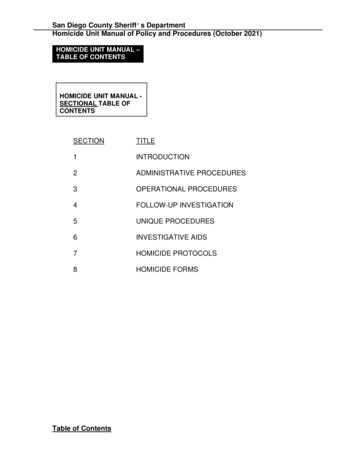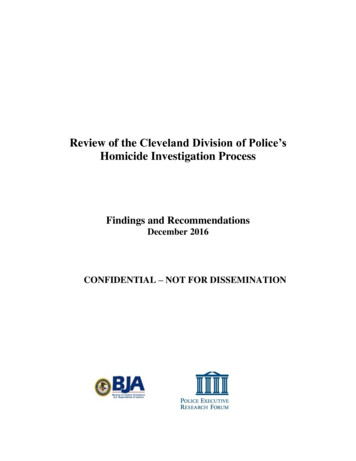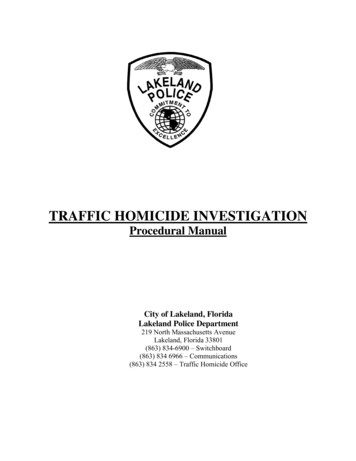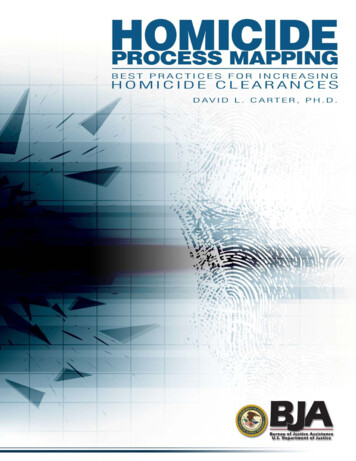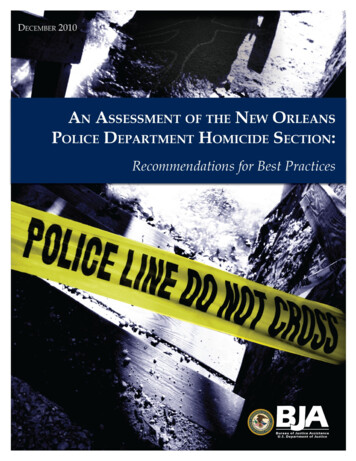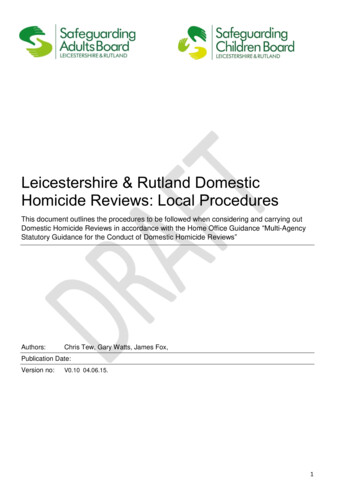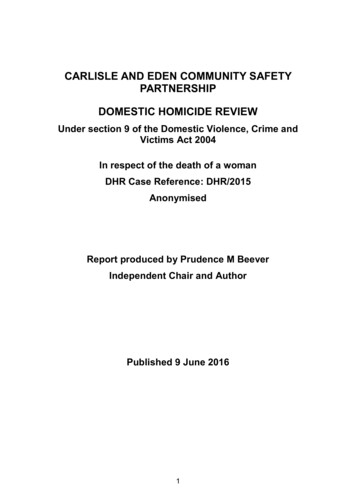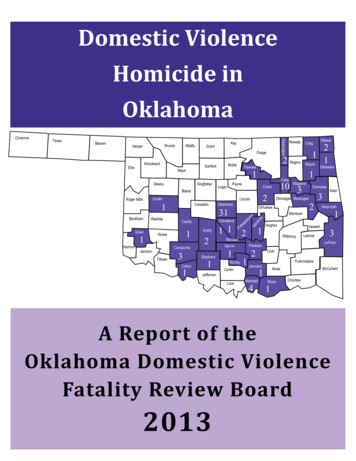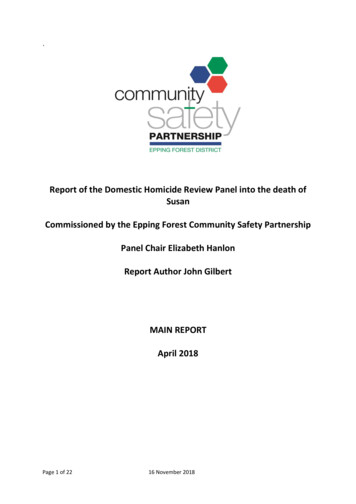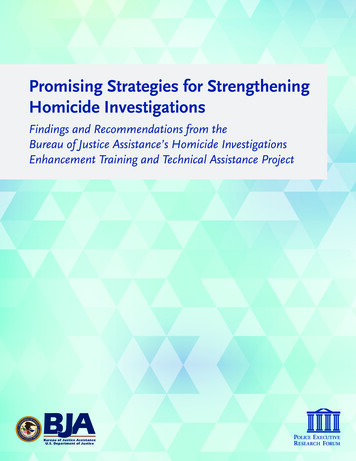
Transcription
Promising Strategies for StrengtheningHomicide InvestigationsFindings and Recommendations from theBureau of Justice Assistance’s Homicide InvestigationsEnhancement Training and Technical Assistance ProjectBureau of Justice AssistanceU.S. Department of Justice
Promising Strategies for StrengtheningHomicide InvestigationsFindings and Recommendations from theBureau of Justice Assistance’s Homicide InvestigationsEnhancement Training and Technical Assistance ProjectOctober 2018Bureau of Justice AssistanceU.S. Department of Justice
This project was supported by Grant No. 2014-DG-BX-K012 awarded by the Bureau of Justice Assistance. TheBureau of Justice Assistance is a component of the Office of Justice Programs, which also includes the Bureau ofJustice Statistics, the National Institute of Justice, the Office of Juvenile Justice and Delinquency Prevention, theOffice for Victims of Crime, and the Office of Sex Offender Sentencing, Monitoring, Apprehending, Registering, andTracking. Points of view or opinions in this document are those of the author and do not necessarily represent theofficial position or policies of the U.S. Department of Justice.Police Executive Research Forum, Washington, D.C. 20036Copyright 2018 by Police Executive Research ForumAll rights reservedinclude ISBN 978-1-934485-46-0Printed in the United States of AmericaCover and text page design by Dave Williams.
ContentsAcknowledgements. vForeword. viExecutive Summary. 1Summary of Findings & Recommendations. 2Moving Forward. 9Introduction. 10Homicide Trends in the United States. 10Challenges to Improving Homicide Investigations. 11Project Overview and Methodology. 13Overview of Publication. 16CHAPTER 1.Homicide Unit Policies & Procedures.19The Importance of Strong Written Policies and Procedures. 19Recommendations: Homicide Unit Policies & Procedures. 20CHAPTER 2.Detective and Supervisor Selection Process. 27Developing an Effective Selection Process. 27Recommendations: Detective and Supervisor Selection Process.28CHAPTER 3.Investigations Training. 33Formal Investigations Training.33On-the-Job Training.34Recommendations: Investigations Training.35CHAPTER 4.Staffing & Caseload Management.41Homicide Unit Responsibilities. 41Homicide Unit Staffing and Structure. 41Homicide Unit Caseloads.42Recommendations: Homicide Unit Staffing and Caseload Management.46CHAPTER 5.Supervision, Accountability, & Oversight.50Leadership and Supervision. 50Case Documentation and Review. 51contentsiii
Performance Evaluation and Accountability Mechanisms.53Recommendations: Supervision, Accountability, and Oversight.54CHAPTER 6.Cold Case Unit. 62Recommendations: Cold Case Unit.64CHAPTER 7.Internal Coordination.74Overall Coordination and Communication. 74Nonfatal Shooting Investigations. 78Other Investigative Units. 86Patrol Units. 87Crime Scene Processing and Forensic Analysis. 90CHAPTER 8.External Coordination. 99The Role of Prosecutors in Homicide Investigations. 99The Role of the Community in Homicide Investigations.106CHAPTER 9.Homicide Unit Equipment and Technology. 114Recommendations: Homicide Unit Equipment and Technology. 115CHAPTER 10.The Future of Homicide Investigations:Digital Evidence, Crime Analysis, and Beyond.116Digital Evidence. 117Crime Analysis. 124Conclusion. 132APPENDIX A:PERF Case Review Metrics. 134APPENDIX B:Homicide Assessment Project Team. 136APPENDIX C:Resources.137APPENDIX D:Homicide Investigations Project Site Convening –January 31, 2017 – List of Participants.140ivpromising strategies for strengthening homicide investigations
AcknowledgementsPERF would like to express its appreciation to the Bureau of Justice Assistance(BJA) for launching this important effort to strengthen homicide investigations andimprove clearance rates. We are especially grateful to BJA Director Jon Adler for hisleadership and focus on violent crime in the United States. Director Adler recognizesthe critical importance of reducing homicides, and that means helping to give lawenforcement agencies resources to clear homicide cases, bring perpetrators to justice,and deter future offenses. Jon Adler and BJA are saving lives by making homicide investigations one of their top priorities.We are also grateful to BJA Deputy Director Kristen Mahoney for her leadershipthroughout this project and on other critical policing issues facing this country. Wewould also like to thank Cornelia Sigworth, Tammy Brown, and Angela Williamson atBJA, who offered ongoing support and guidance during every stage of our work.PERF would like to offer special recognition to the chiefs of police at our fiveproject sites: Baltimore Commissioner Kevin Davis; Cleveland Chief Calvin Williams; Houston Chief Art Acevedo; Miami Chief Rodolfo Llanes (ret.); and Chief ScottSchubert and former Chief Cameron McLay of the Pittsburgh Bureau of Police. Thisproject would not have been possible without the commitment that these leadersdemonstrated to improving their homicide policies and practices. At every step of thisprocess, these leaders – along with personnel throughout the project sites – wereoverwhelmingly cooperative, candid, and willing to discuss new ideas for reform.PERF would also like to thank the law enforcement executives, investigators,researchers, forensic analysts, community advocates, federal officials, prosecutors, andother experts who participated in our January 31, 2017 conference in Washington, D.C.The lessons learned and promising strategies shared by these experts are a valuableresource for any police agency looking to strengthen homicide investigations.Finally, PERF would like to acknowledge the members of the project assessmentteam: Carroll Bollinger, Pam Davis, George Kucik, Ronal Serpas, James Trainum, DavidWaltemeyer, and Charles Wellford. These experts, along with PERF staff membersJessica Toliver, Sean Goodison, Lindsay Miller Goodison, and Lisa Mantel, were responsible for conducting assessments and developing recommendations for the five projectsites. Thanks also go to PERF staff members Adam Kemerer, who provided valuableassistance with coordinating the January 31 conference, and Craig Fischer, who helpededit this publication. Lindsay Miller Goodison took the lead in drafting this report.acknowledgementsv
ForewordBy Chuck Wexler, Executive Director, Police Executive Research ForumLaw enforcement agencies perform a very wide range of duties, including thecritical responsibility of investigating the most serious type of crime: homicides. Andpolice have had significant success in driving down homicides rates. Over the courseof a generation, the national homicide rate has plummeted, from 10.2 homicides per100,000 population in 1980 to 5.3 homicides per 100,000 in 2016.1However, police have had less success in maintaining clearance rates for homicides.The clearance rate is defined as the percentage of cases that are “cleared” when someone is arrested, charged with the offense, and turned over to a court for prosecution, orwhen certain exceptional conditions apply, such as when an identified offender is killedduring apprehension or commits suicide.Homicide clearance rates have been on a slightly downward trend, even as the numbers of homicides declined. Back in 1980, 72 percent of these crimes were cleared.2 Themost recent national data show that police cleared only 59 percent of murders andnon-negligent homicides in 2016.3Solving homicide cases is extremely important for many reasons, not least of which isthat making an arrest can prevent a killer from committing additional homicides. So it isessential that law enforcement agencies amplify their efforts to improve their homicideinvestigation processes in an attempt to reverse the decline in clearance rates.With support from the Bureau of Justice Assistance, the Police Executive ResearchForum conducted a multi-year project in which we assessed homicide investigationpractices in five cities: Baltimore, Cleveland, Houston, Miami, and Pittsburgh. This reportsummarizes the lessons we have learned from those five studies. There is significantvariation in how homicides are investigated, which is what you would expect in a countrywith 18,000 separate law enforcement agencies. However, the lessons in this report canbe applied to law enforcement agencies across the nation.In short, we learned that strong policies, training, and organization can make adifference. Homicide detectives should be guided by clear, comprehensive, written guidance about how to do their jobs. And homicide detectives should be selected for the jobbased on a rigorous, formal process.The level of resources is also critically important. It is difficult to maintain clearance rates if there are too few detectives handling too many cases, or if detectives lacktraining on new issues in forensics and other topics, simply because there is no funding for training or detectives have no time to attend training. The homicide detectives1. FBI Uniform Crime Reporting Statistics https://ucr.f 6/topic-pages/murder and CrimeOneYearofData.cfm.2. “Homicide Trends in the United States, 1980-2008.” U.S. Department of Justice, Bureau of Justice Statistics. See page f.3. FBI UCR Data, https://ucr.f 6/tables/table-17.vipromising strategies for strengthening homicide investigations
interviewed during this project demonstrated a commitment to their profession andsome of the strongest work ethics ever encountered. But in some cases, they are hampered by shortages in staffing and other resources.We also learned that the nature of homicide investigations is constantlychanging. Modern investigations are relying more and more on the analysis of digitalevidence generated by smart phones, computers, social media accounts, and videofootage from security cameras and police body-worn cameras. Additionally, advancesin crime analysis are allowing investigators to better identify crime patterns, drawlinks between people involved in crimes, and build strong cases against suspects.These new investigative techniques require detectives to possess a different set ofskills than in the past, and many police agencies are struggling to keep up. This iswhy we added a final chapter to this report – “The Future of Homicide Investigations:Digital Evidence, Crime Analysis, and Beyond” – which provides recommendations forthe training, tools, and technologies that police agencies need to expand their digitalevidence and crime analysis capabilities.This report is intended to serve as a roadmap to effective homicide investigations, based on policies, practices, and strategies that police departments have foundsuccessful. By closely examining the status quo today, we hope to prevent additionalhomicides from occurring in the future.forewordvii
viiipromising strategies for strengthening homicide investigations
Executive SummaryOne of the most important roles of local police agencies is to investigate incidentsthat involve the loss of a human life due to violence. Thorough investigations of homicides are critical for ensuring that perpetrators are identified and apprehended, forbringing justice to victims and their families, and for protecting the safety of thecommunity.In 2014, the Police Executive Research Forum (PERF) was selected by the U.S.Justice Department’s Bureau of Justice Assistance (BJA) to implement the Homicide Investigations Enhancement Training & Technical Assistance Project. As partof this project, PERF has conducted comprehensive assessments of the homicideinvestigation policies and practices in five police departments: the Baltimore PoliceDepartment, the Cleveland Division of Police, the Houston Police Department, theMiami Police Department, and the Pittsburgh Bureau of Police.The project sites were chosen based on criteria that included: a recent rise inhomicide rates, homicide clearance rates that were decreasing and/or were below thenational average, and a commitment of the police departments’ leaders to improvinghomicide investigation procedures.This publication documents the findings and recommendations that emergedfrom the site assessments, as well as from a conference that was held by PERF andBJA on January 31, 2017, that brought together officials from the five sites and expertsin the field of homicide investigations. The recommendations included in this publication, which are based on research regarding promising investigative practices,reflect many of the common challenges faced by the project sites and other agenciesacross the country.“Improving homicide investigations is a top priority for BJA. One of our keygoals is to invest resources in identifying and improving core competencies forlaw enforcement, particularly as it pertains to fighting violent crime. We areworking to achieve this goal through projects like the Homicide InvestigationsEnhancement Training and Technical Assistance Project, which represents ahuge step toward raising clearance rates and improving how homicide casesare investigated.”— Kristen Mahoney, Deputy Director of Policy, U.S. Department of Justice,Bureau of Justice Assistanceexecutive summary1
Summary of Findings & RecommendationsFollowing are brief summaries of the general findings and recommendations by PERFthat emerged from some or all of the five site assessments and the national conference. This guidance is applicable to all law enforcement agencies that are responsiblefor investigating homicides.Homicide Unit Policies & ProceduresFinding: Effective homicide units are governed by written policies and proceduresthat provide clear, comprehensive, and current guidance on how to conduct aneffective homicide investigation. Recommendation – Update Written Policies: Police agencies should updatewritten standard operating policies and procedures (SOPs) that govern homicideinvestigations. The revised SOPs should include a detailed, step-by-step description of actions to be taken at each stage of the investigation process, as well asmechanisms for ensuring that homicide unit personnel are properly supervisedand are held accountable for their performance. Policy revisions should involvea department-wide focus on examining and updating the written policies for allunits involved in homicide investigations. Recommendation – Revise Policy Content: Policies should include detailed,substantive direction on topics such as: detectives’ duties and responsibilities;selection and supervision of detectives; training; performance evaluations andother accountability mechanisms; and the steps that must be taken during eachstage of the investigative process. Recommendation – Disseminate Policies to All Detectives: New homicide unitdetectives should receive a copy of the revised policies and procedures. Theyshould be trained on and held accountable for following the directives containedin the manual. Recommendation – Incorporate Best Practices into Policies: The revised policies and procedures should reflect the current best practices for homicideinvestigations, including guidance provided in this report. When developingpolicies, police departments should look to research-based practice guides andconsult with police agencies that have demonstrated successful investigativepractices.Detective and Supervisor Selection ProcessFinding: It is critical that police agencies implement a consistent, formal processfor selecting patrol officers to become detectives, for assigning detectives to ahomicide unit, and for selecting homicide supervisors. An effective selectionprocess will utilize standard, objective criteria for determining which candidatesare the most qualified and committed.2promising strategies for strengthening homicide investigations
Recommendation – Establish a Formal Selection Process: Detectives should beselected into the homicide unit pursuant to a rigorous, formal process, using aset of established qualification criteria that are consistently applied to all candidates. Police agency leaders should also implement a formal process for selectingHomicide Unit sergeants, lieutenants, and commanders. The process should bestated in written policy and consistently applied to all candidates. If necessary,police executives should work with the local bargaining unit to revise any collective bargaining agreements that govern detective selection. Recommendation – Establish and Enforce a Formal Probationary Period: Policeagencies should establish and enforce a formal probationary period (e.g., 90-120days) for newly-selected homicide detectives before they are assigned full timeinto the homicide unit. This would allow candidates and supervisors to determinewhether the unit is a good fit for each detective.Investigations TrainingFinding: It is also critical that investigators — particularly those in a homicideunit — receive consistent, formal, and comprehensive investigations training.Training should be offered both to new and veteran investigators. Recommendation – Require Basic Investigations Training: New detectives in allinvestigative units should receive mandatory training on basic investigation skillsand techniques, including case management and documentation, crime scenemanagement, report writing, interview and interrogation skills, basic forensics,evidence collection (including digital evidence), managing witnesses, the use oftechnology, legal requirements, and departmental policies and procedures. Recommendation – Require Advanced Training for Homicide Detectives: Detectives in the Homicide Unit should receive training – both upon entering the unitand throughout their tenure in their unit – on advanced investigative techniquesspecific to conducting death investigations. In addition to the investigative skillstaught to all new detectives, Homicide Unit detectives should receive training onconducting death investigations, constitutional law, advanced forensics and evidence collection, crime analysis, best practices for homicide investigations, andhow to investigate specific types of cases handled by Homicide detectives, suchas officer-involved shootings and child fatalities. Advanced training should reflectthe most up-to-date information regarding innovative techniques and technologies, particularly with respect to tools such as digital evidence and crime analysis. Recommendation – Strengthen On-the-Job Training: Police departments shouldstrengthen on-the-job (OJT) training to ensure that new Homicide Unit detectives receive appropriate field training and mentoring. This includes developingan OJT guidebook and setting benchmarks that new Homicide Unit detectivesmust meet before they are assigned full time to the unit.executive summary3
Staffing & Caseload ManagementFinding: In many police agencies, staffing and scheduling challenges can contributeto heavy caseloads for homicide detectives. PERF has found that an increase indetective caseloads can be associated with a decline in individual clearance rates,as detectives find it difficult to thoroughly investigate, document, and follow up onopen cases. Recommendation – Ensure Adequate Staffing of Homicide Units: A HomicideUnit ideally should be staffed so that each detective is the lead on an average offour to six new homicide cases per year. This recommendation is based on bestpractices4 and on PERF’s finding that an increase in detectives’ average caseloadsize seems to be correlated with a decrease in their individual clearance rates. Recommendation – Restructure Shift Rotation: The Homicide Unit shouldreview data to determine the times of day and days of the week when homicidesmost often occur. This will help the unit assess the times when more detectivesare needed to cover incoming cases. If necessary, the Homicide Unit shouldconsider restructuring its shift and case rotation design to help relieve detectivecaseload burdens. Any new system should be consistent and fairly structured tospread workloads evenly, and there should be room for flexibility as situationschange. Recommendation – Reduce Collateral Work: Homicide Unit detectives shouldspend the majority of their time investigating homicide cases. Departmentsshould limit the time detectives spend performing other duties, such as investigating non-homicide cases, performing administrative work, and serving ondepartmental details. Police agencies should consider staffing the Homicide Unitwith a civilian aide to assist with administrative duties, such as answering telephones, transcribing reports, writing subpoenas, and helping detectives ensurethat case files and other documents are filed properly in both electronic and hardcopy form. Recommendation – Provide Updated Equipment: Police agencies should consider equipping Homicide Unit detectives with laptops, tablets, smartphones, orother devices that enable them to perform tasks while in the field. This wouldhelp them perform their jobs more efficiently and reduce the amount of timetraveling from the field to the office. Recommendation – Leverage Assistance from Civilian Analysts and SpecializedUnits: Police agencies should consider leveraging assistance from specializedunits to help homicide detectives locate witnesses and suspects. Having specialized units serve such functions is considered an effective use of personneland a good practice for homicide investigations.5 Agencies should also explore4. Carter, David L. (2013), Homicide Process Mapping: Best Practices for Increasing Homicide Clearances, Washington, DC:Bureau of Justice Assistance. http://www.iir.com/Documents/Homicide Process Mapping September email.pdf.5. Ibid.4promising strategies for strengthening homicide investigations
embedding a civilian analyst within the Homicide Unit who can provide detectives with real-time information to assist with investigations, such as critical linksbetween suspects, witnesses, and victims. This type of analysis can relieve theburden on detectives and help them identify and follow up on valuable investigative leads.Supervision, Accountability, & OversightFinding: It is important to have mechanisms in place to ensure that detectiveshave the guidance and oversight they need to thoroughly and effectivelyinvestigate homicide cases. This includes ensuring there is strong leadershipwithin the homicide unit, establishing formal case planning and review processes,and implementing a system for objectively assessing and addressing detectiveperformance. Recommendation – Establish Strong Leadership and a Clear Chain ofCommand: Police agency officials should ensure that there is strong andconsistent leadership within a homicide unit. Additionally, the supervisoryresponsibilities of sergeants should be made clear in homicide unit policies andshould be reinforced by top unit leaders. Homicide unit leaders should alsoestablish a clear chain of command within the unit. Recommendation – Strengthen Documentation and Data Collection: Detectivesshould ensure that cases are properly documented. Homicide Unit standardoperating procedures (SOPs) should include detailed instructions on proper casedocumentation and reporting. Police agencies should also ensure that their electronic records management systems can be used effectively by Homicide Unitdetectives. The Homicide Unit should also collect and maintain consistent statistical data regarding measures such as detective clearance rates and caseloads. Recommendation – Establish Investigative Plan and Checklist: At the outset ofeach case, Homicide Unit supervisors should work with detectives to establish adetailed investigative plan and formal case checklist. Sample investigative plansand checklists should be included in the revised Homicide Unit SOPs and shouldbe part of the official case file. Police agencies should consider including prosecutors in the process of developing the formal homicide case checklist. Recommendation – Conduct Supervisory Case Reviews: Supervisors shouldconduct mandatory, regular case reviews for the purpose of identifying potentialnew leads, addressing any gaps in detectives’ investigative processes, and updating the investigative plan. The review process should be outlined in the HomicideUnit SOPs and should include reviews of the investigative plan and c
homicide investigation procedures. This publication documents the findings and recommendations that emerged from the site assessments, as well as from a conference that was held by PERF and BJA on January 31, 2017, that brought together officials from the five sites and experts
